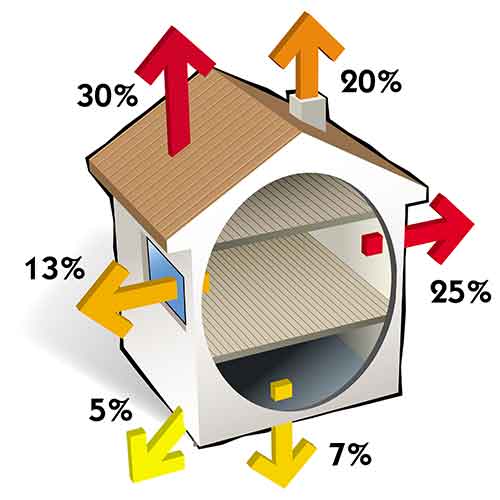Understanding insulation

Why insulate your house?
Choosing effective insulation today is an important decision which will make a considerable difference to your comfort and to the durability of your property.
The purpose of insulation is to create a barrier against the transmission of cold or heat through walls, floors or roofs.
Benefits to insulating a house:
- Energy savings: Effective insulation can reduce the energy consumption of buildings by up to 60%.
- Preservation of environment: through the emission of fewer greenhouse gases.
- Improved comfort all year round: cooler in summer and warmer in winter.
- Increase of the value of your property both for leasing and sale.

Where should insulation be applied?
As with a sieve, it is pointless to plug 80% of the holes if everything can escape through the remaining 20%. The idea is identical for a house. It is better to fit a moderate amount of insulation everywhere than a lot in one place.
Walls and ceilings don’t have the same heat loss characteristics. As hot air is lighter than cold air, it rises as cold air descends (convection). The roof is therefore the surface which is most exposed to the risks of heat loss.
It is important to use airtight insulation, above all in old buildings whose walls are often air permeable.
THERMAL INSULATION IS THEREFORE DESIRABLE FOR SEVERAL REASONS:
- to improve the occupants’ thermal comfort in summer as well as in winter, whatever the temperature changes;
- to save energy;
- to help reduce greenhouse gas emissions;
- to preserve the durability of buildings and in so doing, enhance the longevity of properties.
A few reminders about heat loss
- Heat transfer always occurs from a hot zone to a cold zone.
- Heat transfer only occurs when there is a temperature difference.
- Heat transfer can be represented physically by a thermal flux.
- The purpose of insulation is to reduce thermal flux through walls, floors or roofs
IN WINTER
Because the temperature inside the building is higher than the temperature outside, the heat produced by the heating system tends to escape outside: this is known as heat loss. The purpose of insulation is to reduce that heat loss.
IN SUMMER
In full sunlight, roof tile temperature can reach 60°C and roof slate temperature can rise to 90°C. The roof covering emits a considerable amount of thermal radiation towards the inside of the dwelling, which has an adverse effect on the thermal comfort of its occupants. The purpose of insulation is to block the passage of this radiant heat.
What is reflective insulation?
ACTIS multifoil reflective insulation is made up of multi-layered reflective films, only a few microns thick. These layers, which are separated by wadding, foam, sheep’s wool etc. are sewn together to form a thin insulating blanket.
It is three to five times thinner than traditional thick insulation (including air spaces) but performs to the same standard.
These products are perfectly adaptable for insulating residential, commercial and industrial buildings, in roofs, attics, walls and floors.
Types of reflective insulation
There are a number of reflective insulation products on the market including foil faced rigid insulation and construction boards with flat faced. Traditionally they are installed between timbers or cavities within a thermal element. There are also flexible products with parallel faces but irregular in shape (e.g. ACTIS Hybris).
Reflective multifoil insulation is an airtight multi-layered product composed of a series of reflective films interspersed with separators such as wadding and foam. All the layers put together act as an insulating blanket. These products are typically installed as a continuous layer across structural members (e.g. ACTIS Boost’R Hybrid and HControl Hybrid).
How does reflective insulation act against heat loss?
Generally, reflective insulation reduces heat transfer by counteracting all modes of heat transfer (radiation, convection, conduction…).
They are particularly efficient at limiting thermal transfer by radiation.
Films have usually a high vapour resistance and are reflective. In the case of multifoil blanket insulation, each internal reflective foil of a multifoil insulation acts as an additional barrier to thermal transfer by radiation.
Forms of thermal transfer
Heat is a form of energy which is transmitted from a hot zone to a cold zone, due to temperature difference. Heat is transmitted in 4 different ways, which are also the forms of thermal loss: radiation, convection, conduction and phase change (humidity/wind).
- RADIATION:
Thermal transfer without physical contact
E.g. you can feel the heat being given off by a fire when you sit near to it.
How ACTIS insulation acts against radiation:
The external reflective foils of ACTIS insulation are extremely effective at reflecting infrared radiation back towards the source of heat (heating systems in the winter, and solar radiation in the summer). Each internal reflective foil acts as an additional barrier to thermal transfer by radiation.
- CONVECTION:
Movement of warm air due to a difference in temperature and volume : hot air rises and heat dissipates.
E.g. A radiator heats the air in contact with it (conduction) and the hot air escapes upwards (convection).
How ACTIS insulation acts against convection:
ACTIS insulation reduces cold air infiltration in the winter, and warm air infiltration in the summer, which create thermal losses.
- CONDUCTION:
Heat transfer via physical contact between solids, liquids or gases.
E.g. An electric hob in contact with a saucepan transmits heat by conduction.
How ACTIS insulation acts against conduction:
The low density separators (wadding, foam, etc.) between the reflective foils of ACTIS insulation products, create insulating air gaps, which are also barriers against conduction (same principle as double glazing)
- PHASE CHANGE:
Heat transfer by change in physical state: solid, liquid, gas (the change from gas to a liquid state gives off heat).
E.g. condensation on the bathroom mirror is due to warm water which condenses on the cold mirror.
How ACTIS insulation products acts against phase change:
ACTIS insulation products are water tight.
